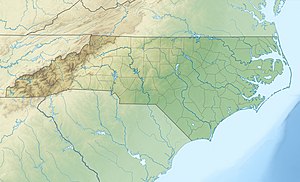| Currituck National Wildlife Refuge | |
|---|---|
IUCN category IV (habitat/species management area) | |
| Location | Currituck County, North Carolina, United States |
| Nearest city | Knotts Island, North Carolina |
| Coordinates | 36°28′06″N 75°51′24″W / 36.4683°N 75.8566°W |
| Area | 8,316 acres (33.65 km2) |
| Established | 1984 |
| Governing body | U.S. Fish and Wildlife Service |
| Website | Currituck National Wildlife Refuge |
Currituck National Wildlife Refuge (/ˈkʊrɪtʌk/),[1] located on the northern end of North Carolina's Outer Banks, was established in 1984 to preserve and protect the coastal barrier island ecosystem. Refuge lands are managed to provide wintering habitat for waterfowl and to protect endangered species such as piping plover, sea turtles, and seabeach amaranth.

Habitat types common to most barrier islands are found on the refuge. Moving westward from the Atlantic Ocean to Currituck Sound, these habitats include sandy beaches, grassy dunes, interdunal wetlands (flats), maritime forests and shrub thickets. Currituck Sound's shoreline is made up of brackish water marshes and occasionally, mudflats that have been exposed by wind tides. A few forested islands also exist on the refuge. Monkey Island, a noted bird rookery, provides nesting habitat to several species of wading birds. It is also currently the most northerly known native habitat of the Sabal minor palm.[2][3] In addition to Sabal palms, vegetation within these diverse habitat types include several varieties of beach grasses, live oak, loblolly pine, wax myrtle, cattails, sedges and rushes, black needlerush (Juncus roemerianus) and giant cordgrass (Spartina cynosuroides).
Various types of wading birds, shorebirds, waterfowl, raptors, mammals (including feral horses), reptiles, and amphibians common to the eastern United States, are found on the refuge. The endangered piping plover and loggerhead sea turtle sometimes nest on refuge beaches and dunes.
The refuge has a surface area of 8,316 acres (33.65 km2).[4]
- ^ Talk Like A Tarheel Archived 2013-06-22 at the Wayback Machine, from the North Carolina Collection's website at the University of North Carolina at Chapel Hill. Retrieved 2013-02-05.
- ^ "Monkey Island Sabal Minor". Old Dominion University. Retrieved 1 November 2013.
- ^ "Gary's Nursery". Gary Hollar. Retrieved 1 November 2013.
- ^ USFWS Lands Report, 30 September 2010


